Lunch with: Hugh Chamberlain
An ex-policeman, he became an engine builder despite no formal training, and took his sports car team to world titles. But, as he tells Simon Arron, there was no plan: “Things just happened…”
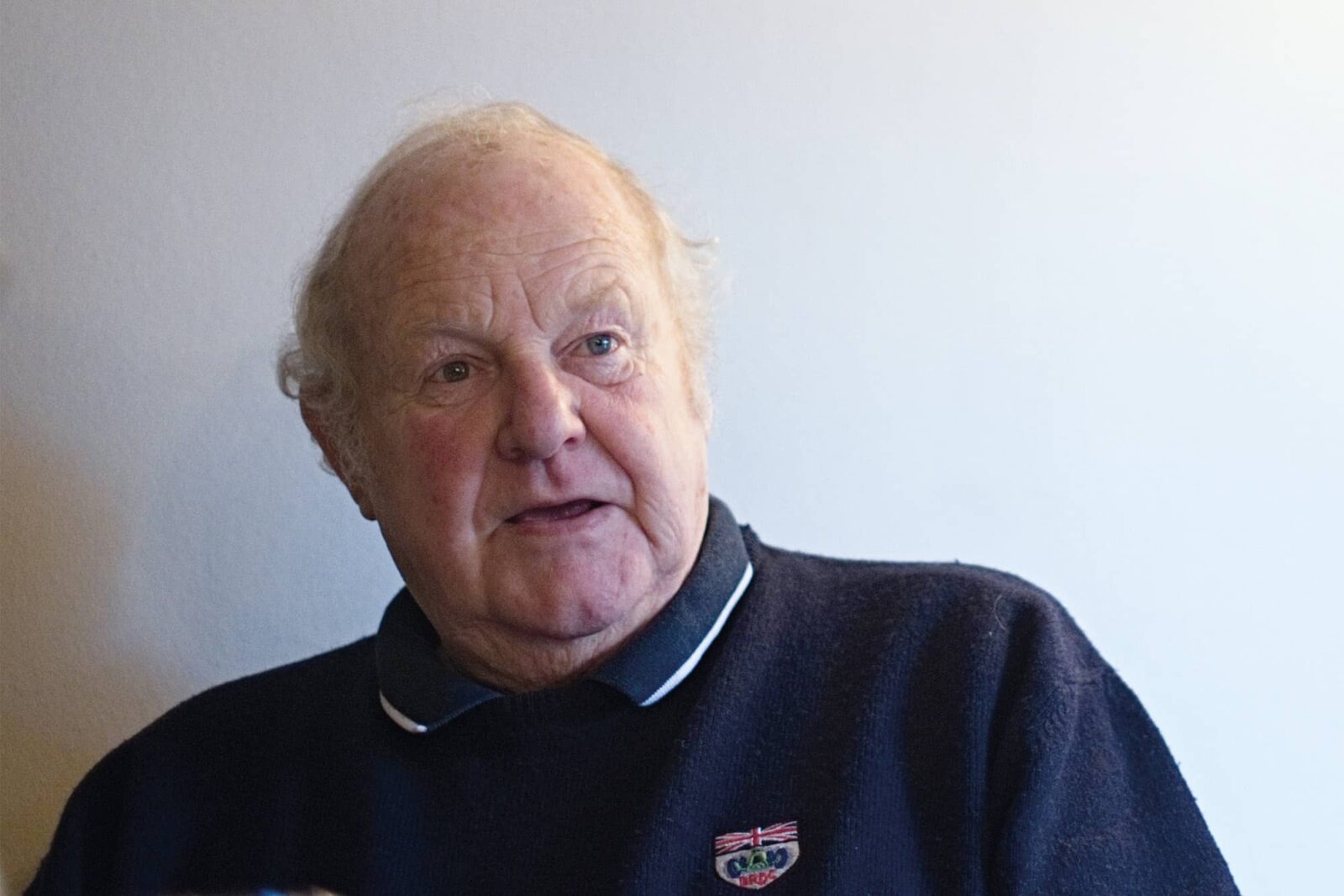
Chamberlain is low-profile, but he helped launch Will Hoy’s career and made multiple attacks on Le Mans
lyndon mcneil
To the wider world, he is almost completely unknown. Within motor racing, he is a hardened perennial, friendly but forthright, a man whose cheerful demeanour masks a steely competitive streak. His love of the sport was fostered when his father took him, aged seven, to watch Silverstone’s inaugural motor race, the 1948 British Grand Prix. His professional engagement came about largely by chance, although that didn’t prevent his eponymous team winning a brace of FIA endurance world titles, nor from taking a Le Mans class win (which might easily have been two but for a misfire). Next year will mark the 60th anniversary of his track debut, but he remains both passionate about the sport and active within it. To discuss his unusual route to the top, he suggests we meet at his local, The Brewery Tap in Furneux Pelham, Hertfordshire, where he orders haddock and chips to accompany his Diet Coke. “I have always,” he says, “been a fairly simple soul.”
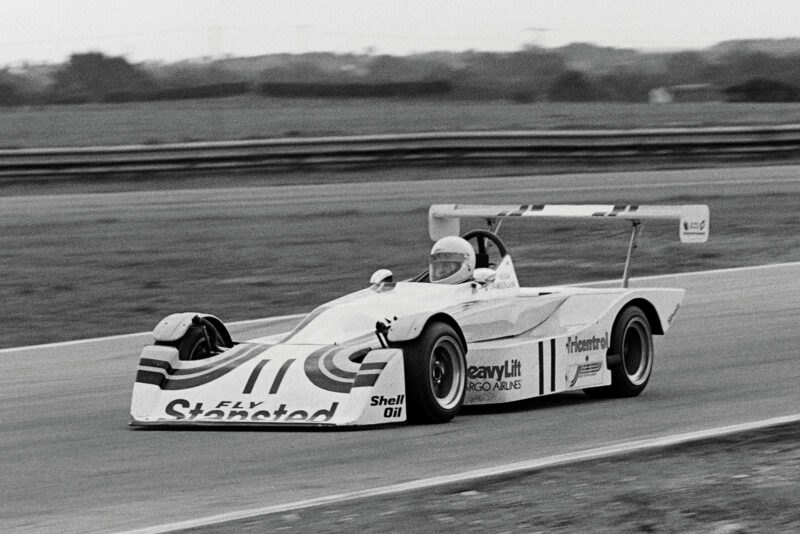
Clubmans proved pivotal to Chamberlain’s career and here he is racing at Snetterton during 1982
LAT
There is an enduring mystery in Chamberlain’s life, one that will likely remain unanswered. “I would love to know how I came to be born in a croft in Sutherland,” he says. “My parents were based in Devonport at the time, although my mum had family in Scotland. She travelled almost 700 miles to the other end of the land heavily pregnant, and presumably with bags and stuff, during The Blitz, but I’ve never known why.” He shrugs, advancing to the more conventional childhood that followed.
“It was about 2am, and I heard this extraordinary sound”
“We lived just outside Towcester, where my father was a headmaster,” he says. “He was very keen on cars and got to know old man Hesketh [father of future Formula 1 team owner Alexander] and Jimmy Brown [later the linchpin of the British Racing Drivers’ Club] – and as we were close to Silverstone, he took me to the first post-war British Grand Prix, in October 1948.
“We watched from the inside of Abbey, which at the time marked the beginning of the start/finish straight, and I was hooked: that was it, no further conversations, this was what I wanted to do. I was bowled over by the whole thing, the ambience, the smell, the noise. And to an impressionable young lad, Ferrari and Maserati sounded like much more fun than Ford or Vauxhall, and certainly more so than ERA… The same with drivers such as Luigi Villoresi and Alberto Ascari – it all seemed very exotic. After that, my father kept going back and helped out with timekeeping and other stuff. I’m not aware of him ever having competed there, though I accompanied him once on a regularity event that he won, and I still have the trophy he was given. I also have a photo of the Northampton & District Car Club team from a Six-Hour Relay in the early 1950s, with an MG Magnette, a Bugatti, a Ford Special and other stuff, and I’m fairly sure he was the team manager. That idea intrigues me, but he died when I was still school age and I have never been able to find out any more.
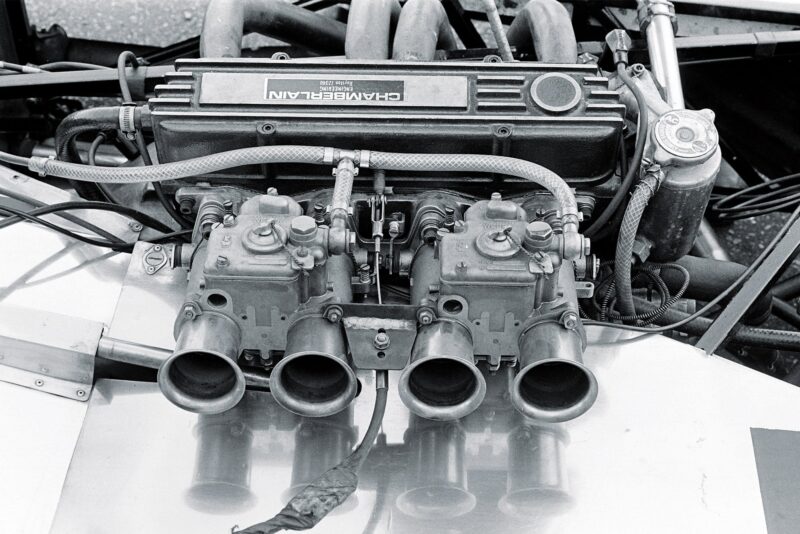
Chamberlain’s engine skills were self-taught; pictured is a Clubmans example
LAT
“In 1948 I also fell in love with Jaguar’s new XK120; it looked so wonderfully different from an MG T-type or any of those other things with cycle wings. I decided straight away that I wanted one – and somehow by 1960, I’d managed to save up enough. I used it for a few sprint events, the first of them at Brands Hatch in 1961 – a Metropolitan Police Motor Club event because by then I had actually become a copper. I finished second, but recall feeling greatly annoyed not to have won – I can’t remember who beat me, but they were driving a Morgan Plus Four.”
Chamberlain was stationed in Kentish Town, North London, and his curiosity was further piqued while on foot patrol one night.
“I suppose it was about 2am,” he says, “and I heard this most extraordinary sound. I saw the nose of something appear at a red light and could see elements of both C- and D-type Jaguars, though it wasn’t either. It had D-type wheels, too, and as it moved off, I could hear it had quite a trick camshaft. I made a few enquiries, tracked it down to a local street with a row of garages and it turned out to be YPK 400, the Cooper-Jaguar. The owner told me he found it a bit ludicrous for the road, which wasn’t surprising. Most of the running gear came from a D-type and I arranged a swap deal with my XK. The Cooper was the first car I raced. I was supposed to make my debut at an Eight Clubs meeting at Silverstone, in ’64 if memory serves, but it all went wrong because I knew John Gott [chief constable of Northants, and a distinguished racer of Austin Healeys] and he asked if he could have a go. I think he just wanted a play, but another driver ran into him and I decided against racing that day. I ended up using the car at several club meetings, but my first marriage was now looming – which meant a house, furniture and other things, so the Cooper was sold for £870 to cover some of that.”
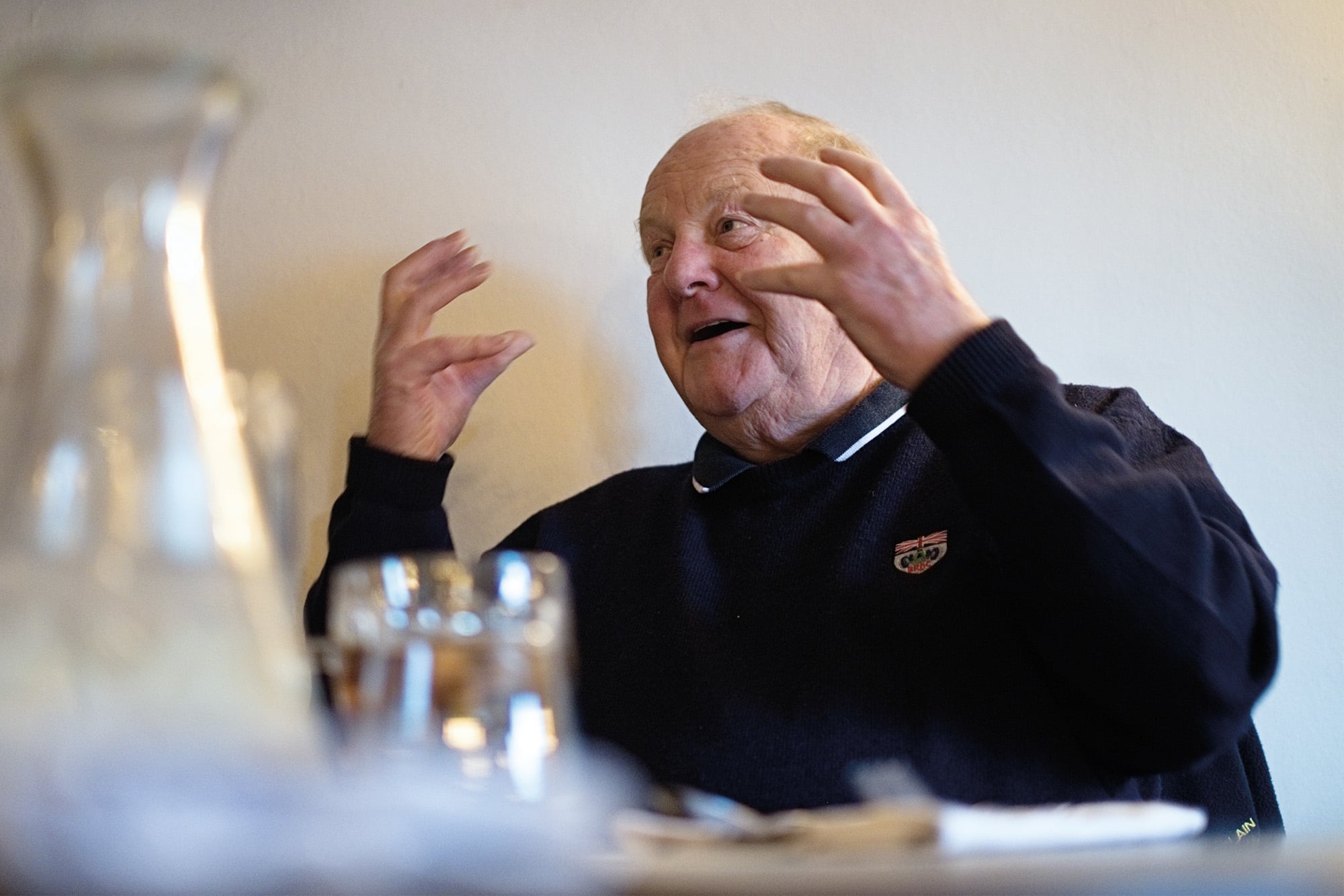
He had now left the Met and was managing a motor parts business for a former police colleague, who had been doing well in London and invited Chamberlain to run a newly opened second store in Hertford. “At that stage,” he says, “I had to start learning a little more about how cars worked.” Not that he was particularly prepared for what followed.
“One afternoon I received a phone call from a chum in Northampton. ‘Ah, Chamberlain – when are you going to come and pick up your stuff from my garage?’ I hadn’t the faintest idea what he was talking about, but it transpired that he’d been collecting bits to build a U2 Clubmans car – this was still before they were known as Mallocks – and his wife had twigged. Faced with the choice of a divorce or lying, he chose the latter and told her the stuff was all mine. I’d never heard of a U2, didn’t want it, and certainly couldn’t afford it, but I’d been his best man and felt I should help, so I went to pick up a chassis and pretty much all the bits, bar engine and gearbox, to put a whole car together.
“At that stage, I barely knew a flywheel from a flat tyre, but I started nailing things together – albeit not terribly well. I had no idea how to fit the front suspension, not a clue. It was a Ford Popular swing axle thing, which needed to be cut, shut and welded. So, I contacted its designer Arthur Mallock and he put me in touch with preparation expert Dave Reeves, who was running a 6B for a guy who was actually quite quick – one Max Mosley. After Dave had done his stuff, my car was identical to Max’s and I now just had to buy and fit an engine and ancillaries. The biggest problem, when I took it to Silverstone for its first-ever run, was that every so often it would jump sideways by about a foot and a half. It was horrendous, though to my surprise I eventually fathomed out what was wrong. I’d bolted a Panhard rod in some hole or other – it was supposed to be roughly parallel to the ground with the driver on board, but it was at quite an angle and whenever you went over a bump, the axle was pulled one way or the other. Working out that problem was perhaps the first indication that I might have some idea about the set-up.
“I must have persuaded people that the WSC was a good idea.”
“Doing the engine was fun because I’d gone around asking what people did and they all seemed to buy their parts from tuners such as Holbay. At that time, Ford had a parts shop in Boreham and you could buy bits, special cranks and so on, off the shelf. So, I went and bought what I thought I needed, then had to work out how to put it together. I found a company in Bishop’s Stortford that sorted me a cylinder head and a pair of carburettors and the car turned out to be very quick… at least for a 6B. By the time I started, the U2 Mk8 was on-stream and much quicker than my car. I wanted to win – and that meant going as hard as you could, which seemed fairly pointless when you were still going to be a couple of seconds off the pace. That was one problem – and the other was that I couldn’t afford it.”
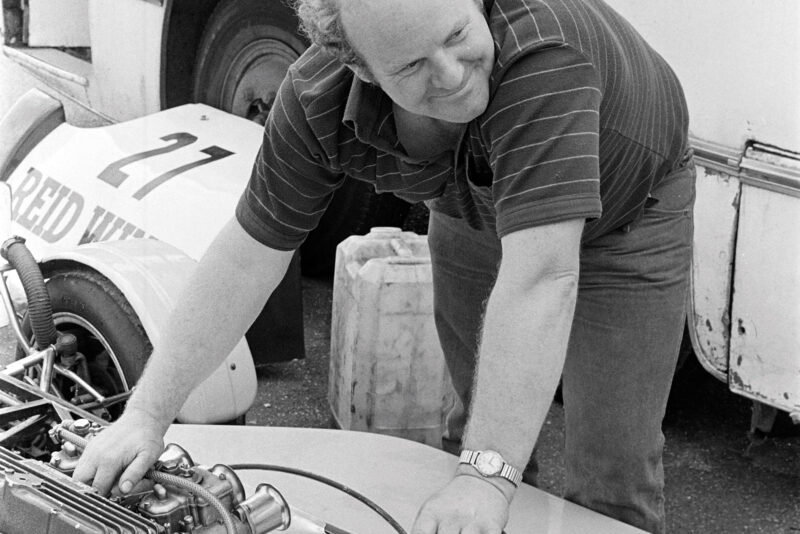
Chamberlain works on Will Hoy’s car. Their career paths would cross by chance
LAT
He had, though, now built his first engine.
“It was one of my regular customers, a lovely chap named Ernie Collins, who suggested that I should perhaps consider starting my own engine-building business. He had lots of stuff, was prepared to help me out, and gave me a boring machine. It was quite old, but still worked, and he taught me how to bore a block, which turned out to be the start of me launching my own company on a small scale. I acquired a head-facing machine and became a reconditioner, running the business from a shed behind my house in Buntingford. I didn’t have room in the garage because the Clubmans car was still sitting in there… I then moved into a small workshop on a farmyard around the corner, but it was fairly obvious that I wasn’t supposed to be there because the local council referred to me as a ‘non-conforming user’. I then bought half an acre of land – the bank wouldn’t help me raise the £24,000, so I had to sell stuff to get up and running, but I’d soon gone from having an old boring block and a head facer to having automated this and complicated that and I was learning how to grind crankshafts. Once I’d got all this kit, a mate suggested I should think about getting back into racing – which I’d love to have done, although my car was by then about 300 years old.”
He solved that problem by acquiring one of Mallock’s 1975 chassis, a U2 Mk16, and producing another self-built engine – this time from a slightly more advantageous starting point. “The trend back then was for drivers to purchase turn-key Holbay or Cosworth engines with steel cranks, at £3000 or more each, but I found I could sell mine at a profit for £1000 or so. They had what I called a ‘wobbly’ crank, a cast-iron thing, and standard pistons rather than anything too expensive. But they were actually pretty quick and worked well, providing you didn’t take them to about 7800rpm, so I attracted a steady supply of customers. I bought a dyno and would stand there, alongside it, with an engine turning over at 7500rpm. If one had blown up, I’d have been history, no question.”
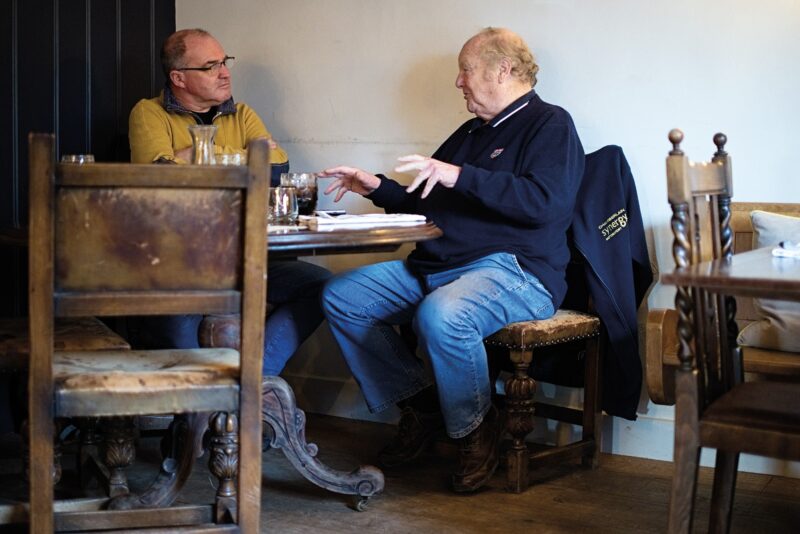
Down the local: Chamberlain recalls his career to our man Simon Arron
Lyndon McNeil
From its foundation in 1972, Chamberlain Engineering had built up a steady flow of work for road and racing customers, but it remained strictly grass roots in outlook. One of the first significant triggers for change came at a boozy evening with team-mates from Royston Rugby Club, where Chamberlain played as a stand-off. “In the bar one day, a back-row forward came up and said, ‘Look, I understand you have a racing car. I would like to have a run in it.’ He was competing in gearbox karts at the time, but I didn’t yet know that – as far as I was concerned, he was just a reasonable rugby union forward. At first I had no interest in the idea, but after we’d had a few pints I was happy to agree to anything and we did a swap deal, he’d try my Mallock and I’d drive his 250 Superkart. So, we went to Silverstone Club and on his second flying lap, he’d done a time that was as quick as I had ever managed. That wouldn’t have mattered were it not for the fact I’m a pompous ass and didn’t want to be beaten by somebody who’d never previously driven a racing car.
“He didn’t know how quick he’d been because he didn’t have the stopwatch, so I just told him that he might be okay if he got a bit more practice.” It was Will Hoy. In March 1982, Hoy qualified on pole for his Clubmans race debut at Silverstone but failed to finish. He had blown his engine during testing the previous day, so Chamberlain had taken it back to his Buntingford HQ, stripped it down, re-ground the crank, found another conrod and put everything back together, but hopes of a debut victory were ended when the throttle cable came undone. Wins soon flowed, however, and frequently so. The reverse part of the swap deal didn’t go quite so well. “Hoy had arranged for me to drive during an official pre-British Kart GP test day on the Silverstone GP circuit,” Chamberlain says. “I somehow had to squeeze into his leathers – some tape might have been involved – and was surrounded by all the biggest kart stars of the day. I did three laps, came in and pretended I’d loved it, but it had been absolutely terrifying. In truth, I loathed it.”
For the next three seasons, Hoy would be one of the drivers to beat, taking a string of titles and in 1984 collecting the third of the Grovewood Awards [the precursor to the Aston Martin Autosport BRDC Young Driver of the Year Award] given to potential rising stars. Aged 32, he was pipped by Mark Blundell and Andy Wallace but placed ahead of commendation recipient Damon Hill. “He soon had people sniffing around interested in signing him for F3, including Eddie Jordan,” Chamberlain says, “and it was fairly clear that it was time to move on.”
“Will said he couldn’t get sixth, I added it only had five gears..”
It was McLaren International director Creighton Brown, one of Hoy’s top Clubmans rivals, who suggested the two should enter the almost-anything-goes Thundersports series, in a Chamberlain-run Tiga-Hart turbo. “It was one hell of a car,” Chamberlain says, “although it never really ran properly.” Even so, it was suitable – once a canopy had been added – to allow Chamberlain to run it in a selected number of World Sportscar Championship events during 1986, alongside his Thundersports commitments. Hoy shared duties in both series with a number of drivers – including former Clubmans star Nick Adams. For 1987, Hoy accepted a full-time deal to race sports cars with rallycross king Martin Schanche, the prelude to a mainstream career that would include the conquest of the British Touring Car Championship title in 1991. He remained active in the BTCC until the decade’s end but died in 2002, aged 50, after contracting a brain tumour. “He was,” says Chamberlain, “a very special talent.”
They would work together again beyond the end of 1986, but the following season they would be racing mostly against each other.
“I think it was Nick Adams who suggested that I should branch out into the world championship full-time,” Chamberlain says. “I had simply never considered it. It sounded crazy; how could we possibly do that? But like most things in my life, it just sort of happened. There was never a plan to do international races. I’m not a world-class manager – and would never profess anything of the kind – but I seem to have a knack for putting together a good group of mates. They don’t have to be your mates beforehand, but they have to become your mate while you are working together – and you can then rely on them to do things properly. I must have persuaded people that the WSC was a good idea and we ended up running a Hart-engined Spice.
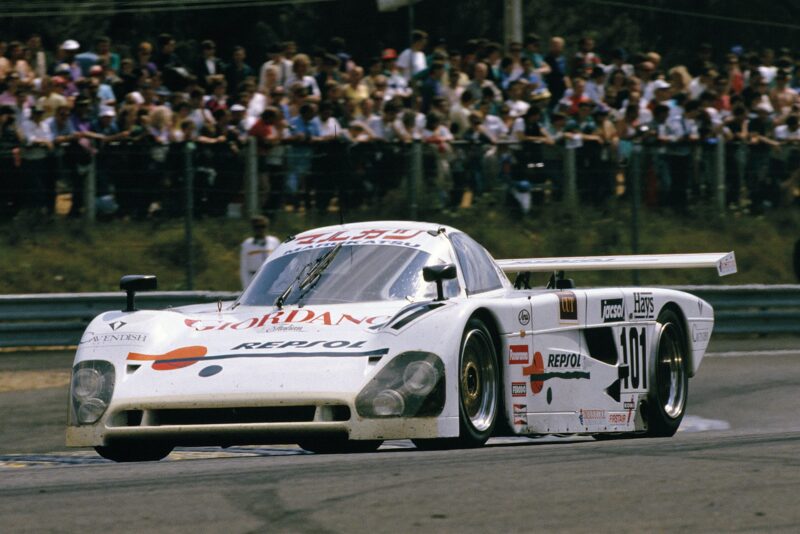
Chamberlain had mixed fortunes at Le Mans; in ’89 the Spice-Cosworth retired
LAT
“In 1987 you still needed to fill in about 57 bits of paper to get a carnet to transport racing cars around. I’d planned the first trip to Monza carefully and knew how long everything would take in our old Bedford truck. At about the time I felt our guys should have been near Lyon in order to get to Monza on time, I received a call telling me they were still in the UK. They’d been across once and had to come back because one bit of paper hadn’t been signed. The truck would only do 54.39mph, but they concocted their own form of cruise control by wedging a broom handle against the throttle to make sure it maintained that pace. Anyway, they got there okay in the end. The following year, I put a French flag by one of the driver’s names because I thought it might make it easier to get by the first hurdle…”
The team’s best results were a string of sixth places in C2, but the following season – now running two Spice chassis, one with a Hart engine and the other a Cosworth – Chamberlain picked up six podium finishes from 11 starts and only once failed to register any points. The factory Spice team won the C2 title at a canter, but Chamberlain Engineering had moved up to second. “Did I feel confident about our chances in ’89? Absolutely,” he says. “It helped that the factory Spice team had graduated to C1, but we had Fermín Vélez alongside Nick and both were bloody quick, so we had a chance. We had a bit more money – probably £50,000, when really you needed five times that, but it represented a step forward.
“In the opening race of the year at Suzuka, we were already miles ahead after our closest rivals hit trouble. We pitted with about 55 minutes to go for our final fuel stop – perfect timing, as the car would do an hour and a bit on a tank. Nick jumped in but I told the guys to leave the car up on its jacks. We were so far ahead that I saw no point rejoining immediately. We weren’t going to be caught by any other C2s and I didn’t care about the C1s, so we could afford to wait for half an hour. They all thought I was mad and were asking what would happen if the car failed to start, but it had about a 4:1 compression ratio and we’d never known it not to start. Jeff Hazell from Spice came down and told me we’d be excluded for not completing a sufficient percentage of the winning car’s distance, but I’d checked the rules and it said only that you had to complete 75 per cent of the mileage covered by the leading car in your class – which was in any case ours. About 20 minutes from the end I sent Nick back out; the drivers weren’t happy because it flew in the face of their instincts, but we won easily.”
“I told Lotus I’d see them in court, they thought it was nonsense“
The duo took their Spice-Cosworth to victory in the first four races, retired at the Nürburgring with electrical trouble and then took podium finishes at Donington Park and Spa before missing the Mexico City finale; they were world champions, as was the former beat bobby steering their ship. They also led at Le Mans (not part of the championship that year), until a misfire stifled their chances. “Looking back,” he says, “I sometimes wonder how the hell we managed to do it, but really it’s quite straightforward. We had the right kit and the right drivers and educated the mechanics that they mustn’t lose any time – the drivers were out there fighting for a tenth here and there, but a fluffed wheel change could cost them 20sec that they weren’t going to get back. We made sure we were as well-drilled as possible; I have a saying about ‘cutting out hindsight’ – it was our job to look at the car, work out what might break and then make sure it didn’t. It’s all simple stuff, the same as making sure a ball goes to hand when you’re playing rugby if you want to minimise the likelihood of the opposition scoring.”
There was no C2 class as such in 1990, all cars running to C1 spec and Chamberlain continuing with a Spice-Cosworth – “I made a mistake by having it bored out to 3.5 litres. It would have been cheaper and more reliable if I’d carried on with a 3.3 C2 engine.” In 1991 the team aligned itself with Dutch entrant Euro Racing, placing fourth in the world championship for teams, and in 1992, the final season for Group C, it was back to being plain old Chamberlain.
“I picked up another team’s Cosworth that had been misfiring through most of ’91 – and took it to Brian Hart. He gave it a quick twiddle and it never missed a beat throughout the campaign, including Le Mans – I think he only charged me a couple of bottles of wine, too. It cost £10,000 to lease the motor for the first race at Monza. After that, I had to buy it if I wanted to keep it, another £15,000. I’d persuaded somebody to pay the entry fee, knew we had enough wheels lying around and we used yellow-coded brake disc pads that nobody else wanted because they were so hard – and designed for Le Mans, but even there they had no feel. We started the year on tyres that had last been run the previous September – they were old then – but we reckoned they’d be fine for Monza as it’s mostly straights. The engine was perfect, the car got better as the year went on – probably because we eventually bought a couple of fresh sets of tyres – and we did it on £50,000.”
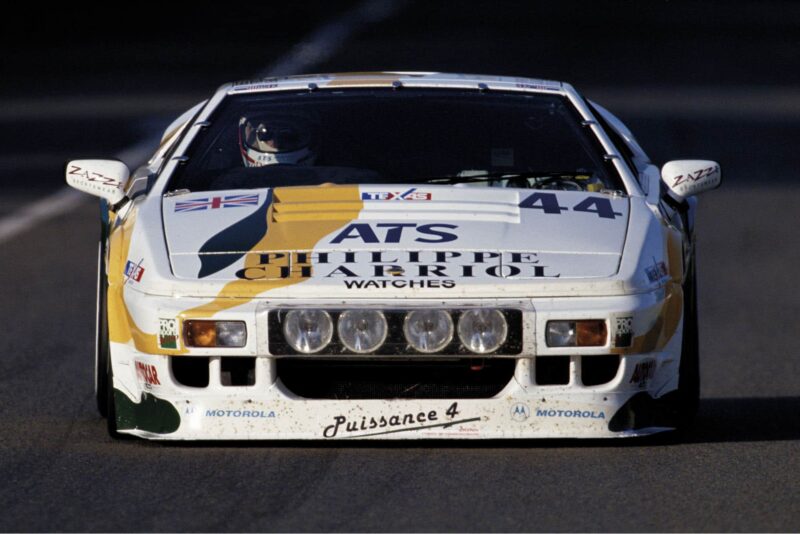
With Group C over, Chamberlain had an ill-fated link-up with Lotus, first racing at Le Mans in 1993
Getty
Lead driver Ferdinand de Lesseps was partnered with various quicker team-mates through the season. He paid £25,000 up front, another £25,000 mid-season and was champion as Chamberlain won the FIA Cup class for privateers at every round, including Le Mans, where de Lesseps was paired with Richard Piper and Olindo Iacobelli. “At the shorter events we’d put the quicker guy in for the first and last stints, then Ferdinand in the middle,” Chamberlain says. “He didn’t put a foot wrong.
“Will did a couple of races with him, at Silverstone and Donington. He initially wanted £3000 for Silverstone, so I told him to f**k off and that if I had a proper budget, I’d look for somebody good! Being a mate, of course, he eventually agreed to drive for free. During practice, he went out, came back in after two laps, opened the door and said, ‘Chamberlain, I can’t select sixth.’ I reminded him it only had five gears and sent him on his way…”
With Group C axed, Chamberlain began to look at GT racing and spoke to Lotus about running factory supported Esprits. “The initial deal was that they’d supply the car and I’d find the running costs,” he says. “After a number of meetings, during which everything seemed to have been agreed, I was summoned to Hethel and told the deal was off. I said I’d see them in court, which they assumed was nonsense, so I left them with a copy of the contract the finance director had signed. They caught up with me before I was off the premises and we had two cars for Le Mans, although they’d barely turned a wheel, and still had stuff such as electric windows.
“The car had great potential – we led the first-ever BPR GT [later the FIA GT Championship] race at Paul Ricard in 1994 and might have won if the engine hadn’t blown. When I eventually went back to Hethel to alert them to how good the car could be and that we wouldn’t have to do much, I was told there was no ‘we’ involved. They didn’t want to see me or the cars again.”
In 1995, Chamberlain entered a Jaguar XJ220 for Le Mans, but it misfired its way through the test weekend and failed to pre-qualify. He then switched to running Chrysler Vipers in endurance events. Then came the MG project, announced amid much fanfare by the Phoenix Consortium that had purchased the marque in 2000. “I probably can’t talk too much about that,” he says, “because it all became quite political. When I first saw the contract in January 2001, it said, in black and white, ‘You will enter and win the Le Mans 24 Hours.’ I wasn’t about to sign that… At that stage, another investor had bought into my business, but things didn’t really work out between us. I was at Le Mans in 2001 and 2002 because there was a piece of paper specifying that I was supposed to be team manager, but I wasn’t as involved as I could have been.”
He ended up walking from what had been his own business to hook up with amateur racer Gareth Evans. Their Chamberlain-Synergy Motorsport partnership ran TVRs at Le Mans in 2004 before switching to Lola sports-prototypes, winning the 2005 LMP2 title in the European Le Mans Series (Evans sharing driving with Bob Berridge and Peter Owen) and continuing in endurance racing until 2008. Since then, Chamberlain has been an independent consultant and advisor to a variety of teams.
“I’ve been very lucky,” he says, “and still love being involved. Over time I’ve had some very good drivers, and some not so good. At Le Mans one year we entered an American as part of our Spice-Hart line-up. He came to the workshop and claimed to have raced Indycars, though it all seemed to be bollocks. But he did have the right licence and £10,000, which was manna to us. He wouldn’t listen to instructions, though, and couldn’t start the car when he first got in. It then took him about three attempts to get out of the pits, even though the car was very tractable and easy to drive. He got as far as the Dunlop chicane, spun off and then tried to restart by pressing the fire extinguisher button, the effect of which caused him to throw up in his helmet. And all in his first 800 yards. When the car came back I made him hose out the interior, after which he jumped in his hire car. And we never saw him again.
“But through it all, I’ve always loved Le Mans – it goes back to making a crystal radio set when I was at school and using it to listen to the race commentary, probably by Raymond Baxter, when Jaguar scored its first win in 1951. I can’t have regrets, though I suppose it would have been nice to tackle the race with the right sort of money at least once…”
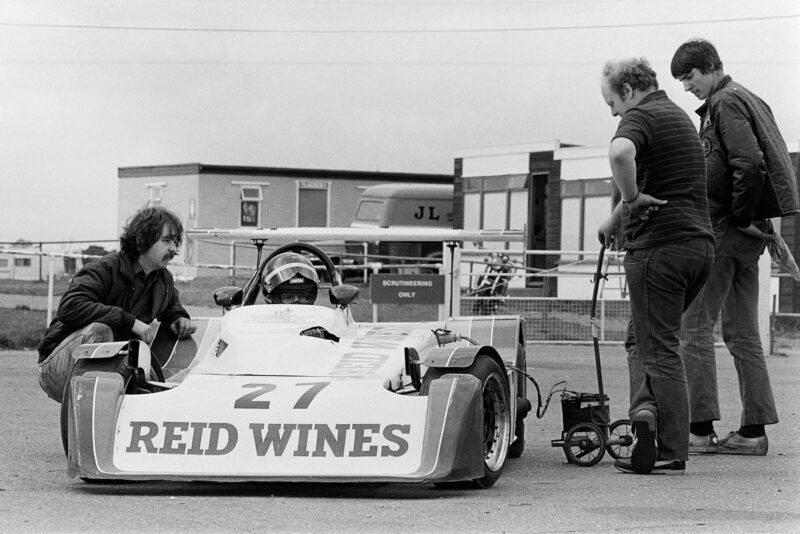
Chamberlain tending Will Hoy’s Clubmans car back in 1982
LAT
Born: 08/09/1941, Lairg, Scotland
1948 Falls in love with motor racing at the British Grand Prix
1961 Racing debut in Jaguar XK120 in a sprint at Brands Hatch
1964 Runs selected events in a Cooper-Jaguar
1968 Acquires first Clubmans car, U2 Mk6B
1972 Sets up Chamberlain Engineering; subsequently returns to Clubmans as a driver
1982 Clubmans link-up with ex-rugby team-mate Will Hoy
1985 Thundersports, running Tiga-Hart for Hoy and Creighton Brown
1987 Graduates to World Sportscar Championship
1989 Chamberlain Engineering wins FIA Group C2 world title with Spice-Cosworth; Nick Adams and Fermín Vélez are champions
1990-91 Runs as Group C privateer
1992 Chamberlain wins FIA Cup class in every round of the WSC, including Le Mans
1993-94 GT programme with Lotus Esprit
1997-99 GT, Chrysler Viper
2001-02 Le Mans, Lola-MG
2004-08 GT & endurance, Chamberlain-Synergy Motorsport
2009-present Diverse consultancies, recently working with Radical and European Le Mans Series entrant 360 Racing
